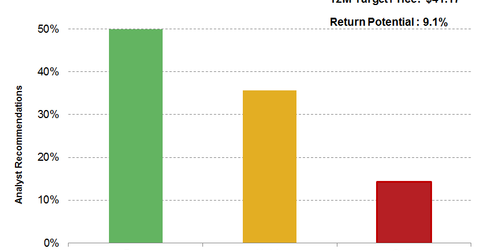Why Have Some Analysts Become Less Positive on American Airlines?
Out of the 14 analysts tracking American Airlines (AAL), 50% have a “buy” recommendation on the stock as compared to the 71.4% that had a “buy” rating in 2Q16.
Nov. 20 2020, Updated 3:54 p.m. ET

Analyst views
Analysts’ recommendations or changes to recommendations can indicate a shift in a stock’s long-term trend and thus have a significant impact on the stock price. Investors should, however, also be aware of the possible conflict of interest.
According to the Bloomberg consensus, out of the 14 analysts tracking American Airlines (AAL), 50% have a “buy” recommendation on the stock as compared to 71.4% of the analysts that had a “buy” rating in 2Q16. Currently, 35.7% have a “hold” rating and 14.3% have a “sell” rating.
Target price
However, most analysts have reduced their target price. American Airlines’ consensus 12-month target price is now $41.17 versus $43.89 at the end of 2Q16. The current target price indicates a 9.1% return potential as of the October 7, 2016, closing price of $37.73. Joseph Denardi from Stifel has maintained his “buy” rating and has the highest target price of $50. Buckingham Research Group’s Daniel McKenzie follows with a $49 price target and has also maintained his “buy” rating. Darryl Genovesi from UBS and Julie Yates from Credit Suisse have the lowest target prices of $38 and $34, respectively.
American Airlines (AAL) forms 1.5% of the Guggenheim S&P 500 Equal Weight Industrials ETF (RGI).
Series overview
AAL is expected to announce its third quarter earnings for 2016 on October 20. In the next few articles, we’ll discuss what led to these estimates. We’ll also help you understand what may be priced into the stock.
You can also check analysts’ estimates for Delta Air Lines (DAL) and United Continental (UAL). We’ll also be doing a 3Q16 preview for AAL’s niche legacy peer Alaska Air Group (ALK).
